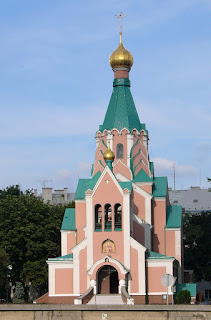Since we have been working so hard since we have been in Europe,
we were given two weeks off for spring break.
The first week we went to Vienna, Austria and Venice, Italy. When we first got to Vienna, I could tell that
it was different than any other European city that I’ve been to so far. Walking down a main street that connected our
hostel to the city center, I almost felt like I was in New York City. The buildings were all newer and full of mostly
American stores. The palace there was
probably one of the nicest buildings I have seen since I have been in
Europe. It is obvious that Vienna was
where the rulers of the Austria-Hungarian Empire once lived. The Habsburgs (the old royal family) decided
a few hundred years ago that they wanted Vienna to be known as a “modern” city,
so they basically demolished the entire city and rebuilt it. Churches were the only buildings that they
didn’t tear down. The city is laid out
in circles, so it is much easier to get around that in cities that haven’t been
reorganized since the medieval times. It
is crazy to me that the city had enough money that they could just start over
and build everything from scratch.
The second day in Vienna we went to the Vienna Imperial
Treasury Museum. The treasury contains many
artifacts from the Habsburg family over the years. There are traditional clothes that were made
in year 1,000 that were preserved so well they still look the same as they do
in old paintings. I also went to the museum
of natural history. There were a lot of
displays of stuffed animals, and even the skeletons of dinosaurs and other pre-ice
age animals.
After visiting the museums we were free to do what we wanted
for the rest of the day. I went
wandering around the city with a couple of friends and we found a park to relax
in for the afternoon. The park was full
of people just laying around in the grass hanging out. I wish that more people in Nebraska spent
their time outside in parks instead of inside all the time.
We have been eating a lot of schnitzel since we have been
here, but were told about two places in Vienna that had the best
schnitzel. The first place we went to
had loaded schnitzel. It was normal schnitzel,
but was stuffed with ham, cheese, and mushrooms. The second night we went to a restaurant that
is considered the “King of Schnitzel.”
This restaurant made theirs very thin, and it was amazing. It is typically served with potato salad, but
the way the potato salad here was more liquidly like a sauce. As much as I like schnitzel, I always have
thought it would be better if there was some sort of sauce or gravy to put on
it, and it definitely made it a lot better.
Schnitzel from "Schnitzel King"
After two days in Vienna we left and headed for Venice. Stepping off the bus in Italy was like
feeling the first day of summer, because the Czech Republic is always so
cold. Once again, Venice is a city that is
different than any other city we had been to before. There weren’t really any roads, just outside
hallways that ran between all the houses and shops. I ate a lot of seafood during the two days I
was in Venice, even though it was pretty pricy it was worth it.
A view of the gondolas in Venice
Here are some more pictures!
Vienna:
Venice:













































